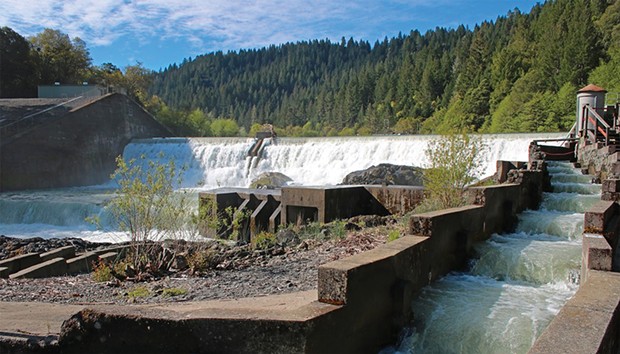
JOHN HEIL/UNITED STATES FISH AND WILDLIFE SERVICE
Cape Horn Dam sits on the Eel River, about 4 miles from Potter Valley.
[
{
"name": "Top Stories Video Pair",
"insertPoint": "7",
"component": "17087298",
"parentWrapperClass": "fdn-ads-inline-content-block",
"requiredCountToDisplay": "1"
}
]
On Sept. 12, storm Daniel overwhelmed two neglected dams in Libya. The flood washed away entire neighborhoods in the coastal city of Derna, killing thousands.
Experts warned just last year that lack of maintenance risked failure of the dams, built in the 1970s to allow the development they destroyed. But storm Daniel brought more rain than builders ever planned for. Because warmer air absorbs more water, Earth's warming atmosphere brings increasingly intense storms.
Northern Californians don't need to look far to find dangerous dams built in inappropriate places. In 1908, Cape Horn Dam was built across the Eel River to divert water into the East Branch of the Russian River, where a powerhouse first supplied electricity to Ukiah. But the dam's small reservoir quickly silted up.
Thus, a much grander structure was proposed 12 miles upriver. At more than 140 feet, Scott Dam created a 75,000-acre-foot reservoir atop Gravelly Valley. However, while Scott Dam was being built, high water in November of 1920 revealed that the outcropping of bedrock to which builders planned to anchor the dam's south end was in fact a giant boulder — which slid downhill in the flood.
The builders managed to complete Scott Dam by angling it in front of the boulder. The unplanned design and the huge boulder created risk factors, which are amplified today by the steady buildup of sediment against what is now a century-old structure.
But all these risks are compounded by the discovery that Scott Dam and its Lake Pillsbury reservoir sit on the Bartlett Springs Fault. USGS researchers have mapped the Bartlett Springs Fault for more than 100 miles and assessed it as capable of producing quakes far greater than Scott Dam was ever designed to withstand.
PG&E, which owns both Eel River dams as part of its Potter Valley Project, is taking the problem seriously. The utility recently announced that seismic risks have compelled it to permanently reduce water storage in Lake Pillsbury reservoir by some 20,000 acre feet. And most significant of all, the utility has signaled its intent to remove both Scott and Cape Horn dams.
Like the threat of earthquakes, the risks climate change poses for obsolete dams like Scott and Cape Horn is still coming into focus. Scientists studying sediment deposited at river mouths found that Northern California has experienced storms in the relatively recent past that were much larger than those that inundated the Central Valley in 1862, or the 1964 flood in which the Eel River carried more water than the Mississippi. The last real mega-flood was in 1605. The worst storms ahead will thus be amplified versions of that 1605 storm.
Dam regulators must evaluate dam safety not against the floods that seemed likely when dams were built, but those that we know are possible today. The obvious lesson of Libya's tragedy is that aging, poorly maintained and inadequately regulated dams can and do fail in the face of floods larger than those the dams were designed to handle. That's a big reason we should remove our own obsolete, unsafe (and fish-killing) dams, like Scott and Cape Horn, as soon as possible. Russian River water interests that have long benefited from Eel River diversions seek to delay Eel River dam removal, seemingly oblivious to the plain facts: The Potter Valley Project has ceased to produce power, can provide only minimal diversions to the Russian, and is at real risk of catastrophic failure. It's time for the Eel River dams to come out.
Alicia Hamann (she/her) is executive director of Friends of the Eel River. She's also an avid gardener, beautifying Eureka one native plant at a time.
Comments (3)
Showing 1-3 of 3
Latest in Views
Readers also liked…
-
Hope
- Sep 7, 2023
-
California Says No to Privatizing Medicare
- Sep 21, 2023































